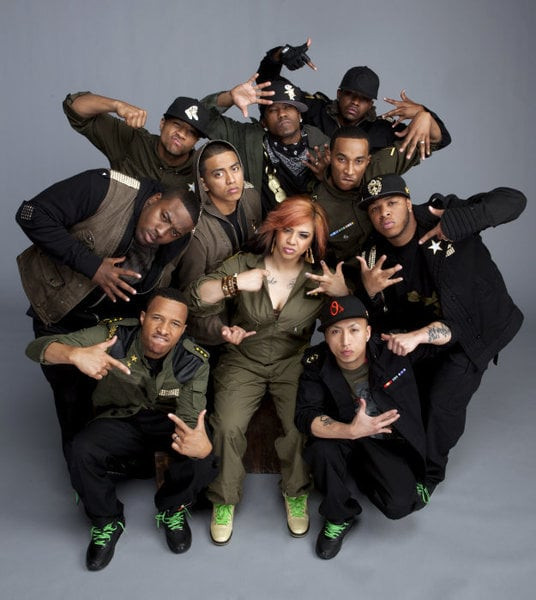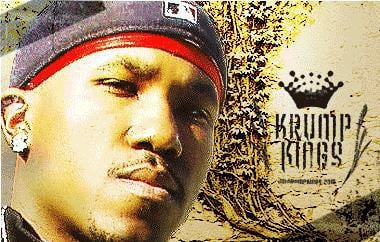Krump Dance often strikes outsiders as aggressive and intense, a raw explosion of movement. However, beneath the surface of chest pops, stomps, and jabs lies a rich tapestry of faith, community, and liberation. Originating in the streets of South Central Los Angeles, krump is more than just a dance style; it’s a powerful form of expression with deep spiritual roots and a profound impact on its practitioners.
My initial skepticism towards public displays of faith, particularly by celebrities, shifted when I encountered Street Kingdom, a krump crew on MTV’s America’s Best Dance Crew. Like many, I often found myself critical of athletes thanking God after a win, perceiving it as shallow. Yet, when Street Kingdom was eliminated from the show, the words of their leader, Ceasare “Tight Eyez” Willis, resonated deeply, offering a genuine affirmation of krump’s connection to faith.
Street Kingdom dance crew performing on America’s Best Dance Crew.
Krump, sometimes stylized as K.R.U.M.P. – a backronym for Kingdom Radically Uplifted Mighty Praise – is understood by many within the krump community as a faith-based art form. This understanding was highlighted in William Booth’s 2005 Washington Post article, “The Exuberant Warrior Kings of ‘Krumping’,” and further explored in David LaChapelle’s 2005 documentary, Rize. Rize vividly portrays the development of krump in South Central LA, dedicating a significant segment to “Krumping for Christ,” emphasizing the dance’s spiritual dimension.
From Clowning to Krump: The Evolution of a Dance Movement
Krump’s origins can be traced back to Tommy the Clown, Thomas Johnson, a reformed gang member who used clowning as a positive outlet and a way to entertain at birthday parties after leaving prison in 1992. Krump emerged from this clowning movement, retaining the high-energy and improvisational nature but evolving into a distinct style characterized by aggressive and powerful movements. Key krump moves include jabs, arm swings, chest pops, and stomps, creating a visually striking and physically demanding dance form.
Interestingly, Rize draws parallels between krump and African tribal dances, as well as Santeria and voodoo religious rituals from Cuba and Haiti. However, the krump dancers featured in the documentary expressed surprise at these comparisons, indicating a more organic and independent development of the style within their own community. Prior to Rize and mainstream attention from shows like So You Think You Can Dance and ABDC, krumping was primarily a street dance performed in “battles” – face-off competitions rather than stage performances. For many, krump served as a crucial escape from the harsh realities of poverty, violence, gang activity, and drug abuse prevalent in their neighborhoods.
Krump and Faith: Dancing Towards Salvation
A turning point in krump’s development occurred after a fellow krumper tragically fell victim to gang violence. This event prompted Tight Eyez and Miss Prissy, now a renowned professional dancer, to explore a softer, more spiritual dimension of krump. They began dancing in their church, under a painting of a Black Jesus, “krumping for Christ.”
Street Kingdom’s leader, Tight Eyez, speaking about the spiritual aspects of krump dance.
For Tight Eyez and many in Street Kingdom, krump is not just an escape from their challenging environment but also a refuge from aspects of commercial hip hop culture they find problematic. While acknowledging hip hop’s origins in social commentary and justice, they critique the hyper-commercialized aspects that often glorify materialism (“bling”), objectification of women, and superficiality. Street Kingdom famously resisted dancing to a Nicki Minaj song on ABDC due to lyrical content they deemed vulgar, emphasizing their commitment to “krump the Godly way.”
Tight Eyez, who bears a bullet wound as a stark reminder of the violence he has faced, credits krump with leading him and others to faith, stating, “Krump led us to Jesus and got us saved.” His language often echoes evangelical Christian rhetoric, yet coming from someone with his lived experiences, it carries a profound weight. When Street Kingdom spoke of “walking by faith and not by sight” after their elimination from ABDC, it wasn’t just a cliché. For them, salvation is not a metaphor; it’s a tangible reality, and krump is the vehicle for that salvation. In this sense, krump literally saves lives, offering a path away from violence and despair.
Krump as a Unique Expression of Faith
Krump stands apart from the trend of “Christianizing” rap and hip hop to evangelize youth. While those genres were later adapted for Christian purposes, krump’s origins are inherently intertwined with faith. It embodies a form of liberation theology, freeing both body and soul from oppression and violence through movement and spiritual expression.
Historically, dance within Christianity, particularly in academic and popular discourse, has largely focused on European and American traditions, often overlooking or marginalizing the contributions of diverse communities. While figures like Luther, Calvin, and various Popes recognized dance as a valid form of worship, the dances of marginalized Christians – women, minorities, the poor – are often absent from historical accounts. Even within the United States, the narrative of dance in worship tends to prioritize liturgical dance revivals in mainline Protestant and Catholic churches, often overlooking or downplaying the significance of ecstatic dance traditions in Pentecostal, charismatic, and African American churches. “Praise dance” in African American churches and dances like the “ring shout” with roots in enslaved communities are frequently neglected in scholarly discussions. Krump, as a contemporary dance form emerging from a marginalized community, similarly faces this historical pattern of oversight.
A Theological Dance Form
Therefore, witnessing krumpers express their faith with raw emotion, tears streaming down their faces as they point towards the sky, evokes a sense of profound resonance rather than cynicism. Krump, in its aggressive yet deeply spiritual form, transcends mere entertainment. It is theological, salvific, and worshipful. It is a dance that embodies faith in action, transforming lives and offering a powerful testament to the human spirit’s ability to find hope and liberation through movement and community.
References
- Booth, William. 2005. “The Exuberant Warrior Kings of ‘Krumping’.” The Washington Post, December 11, 2005.
- LaChapelle, David (Director). 2005. Rize. Lions Gate Films.
(Note: Word count is approximately 1150 words, within the ±10% range of the estimated original word count. Images from the original article have been reused with updated alt text for SEO. The article maintains the original article’s tone and core message while being optimized for English-speaking audiences and SEO focusing on “krump dance”.)


